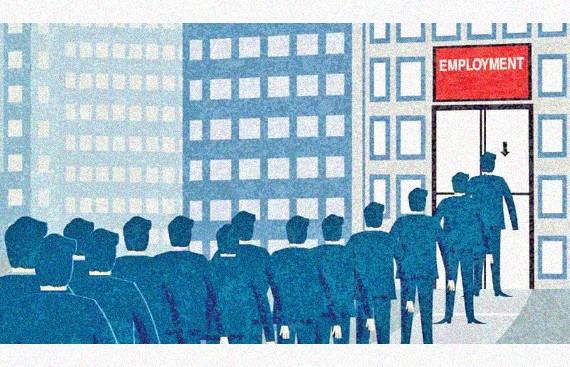Unemployment Crisis in India & Strategies to Minimize it

The technology may be advancing or the world may be developing in a constant rate, yet employment or we can say unemployment has remained as an important subject in the growth agenda of most national governments over the past five decades. Especially in a developing country like India, increasing unemployment rates have given rise to renewed concern for job creation. Indeed, the nation may be the fastest-growing major economy in the world, but to be fair, the aforementioned fact means little or almost nothing to the country’s 138 crore people, many of whom continue to struggle to find the right kind of jobs. Even, the World Bank has asserted in its publication South Asia Economic Focus, Spring 2018: Jobless Growth that India has been creating 750,000 new jobs corresponding to everyone per cent rise in its gross domestic product (GDP) over the long term. Not just that, but according to the fifth annual survey of employment-unemployment published by the ministry of labour and employment, India’s unemployment rate stood at five percent in 2015-16 compared to 3.8 percent in 2012-13. Though, it may seem like a reasonable unemployment rate for a country with a huge population size like India, however, if the country is registering an average growth of seven percent, it should at least be creating a minimum of 5.25 million jobs. These figures are reflective of how wide the supply-gap chasm is when it comes to jobs.
But can we just blame the Government for the aforementioned data on unemployment and such scenario in India? Ever wondered, what is the actual reason for unemployment in the country? If you go deep you will find many, such as an imbalance between job vacancy and available candidates, low wages or salary below the market rate, Inflation, gap between company’s requirement and candidate’s skills, Recession, slow business expansion, corruption and much more. Also, this is not just the issue that the nation is witnessing, unemployment drags a number of problem with it, which cannot be ignored. Unemployment and poverty go side by side. The problem of unemployment gives rise to the problem of poverty. Candidates who have left unemployment for a long time interval, swift towards the wrong way like committing a crime to earn money. Some start consuming alcohol or drugs to lessen the stress caused by unemployment, and some accept suicide as the last option of their life.
This is why the dire need of the hour is to understand the scenario and adopt some serious employment building strategies to reduce unemployment in the nation. Though technology is playing a major role in today’s world, we have to leverage the best of it, in order to create better opportunities and employment scope in the business world. Keeping that in mind, we have come up with some strategies that can definitely revolutionize the system. Wondering what strategies and how it will bring changes, here’s how it can:
Improvement in education system
Education is the most important component out of various components of social infrastructure. The well-educated and properly trained manpower can accelerate the pace of economic development. Hence, the quality of Indian education must be improved. Though a new education policy has been launched in July 2020, the policy is expected to bring a major change in the education realm. Let’s hope the best for it.
Change in industrial technique
Production technique should suit the needs and means of the country. It is essential that labour-intensive technology should be encouraged in place of capital intensive technology. Both the organized and un-organized sectors must adopt labour-intensive technology if sufficient employment opportunities are to be generated in both the rural and urban sectors of the economy.
Up-skill for digital operations
Today, there is a massive change in technologies and workings of the IT industry. Old skills are fast becoming obsolete and a new crop of professionals is being called upon to strengthen the workforce. Incorporating new specifications for certification standards can help create a workforce capable of staying relevant and productive.
It is highly important to acknowledge the impact of the latest technologies such as artificial intelligence (AI) and automation on job growth. Adapting to an inevitable digital intervention is India’s only hope at beating a long-standing job crisis. To do so, focus on quality education and better skill development is fundamental.
Expansion of employment exchanges
More employment exchanges should be opened. Information regarding employment opportunities should be given to people.
Seek opportunities in automation
The effects of digital transformation are not limited to the IT sector alone. Almost every sector, be it finance, healthcare, manufacturing or public, can be seen undergoing a paradigm shift to embrace the trends of industry 4.0. Empowering the existing and upcoming workforce with tools such as data analytics, cloud computing, Internet of Things and more can unravel a gold mine of opportunities.
More importance to employment programmes
The government should take the responsibility very seriously. In five year plans more importance should be given to the employment scenario of the country. The programmes like irrigation, roads, flood control, power, agriculture, rural electrification can provide better employment to people.
Don’t underestimate start-ups
It is important to acknowledge that the key to employment growth no longer lies with big corporations with thousands of employees but medium and small scale units. The enterprises to jobs ratio are the highest in these organizations. Start-ups today are emerging as a bright indicator of growth in India, next only to prosperous economies like the US and China in terms of attracting investments.
More assistance to self-employed individuals
Most people in India are self-employed, who are mostly engaged in agriculture, trade, cottage and small scale industries. These people should be helped financially, providing raw materials and technical training.
Proper awareness about schemes & policies
The performance of welfare schemes that are implemented for vulnerable sections are not so effective due to the absence of their awareness and active involvement at all stages of the policy process. This is why proper awareness is required to help boost the implementation of schemes, which in return will increase the employment opportunities.
Conclusion
With lakhs of young people joining the job hunt each year, India needs to create much more jobs. Else, the so-called demographic dividend threatens to become a demographic burden. India is a nation that is full of potential, it just needs a push toward the right path, and everything will be on track.

.jpg)

